Review: Nokia 5500 Sport Review
Smaller than a smartphone! Smarter than a dumb phone! Is it a bird? is it a plane? No, it's... the Nokia 5500
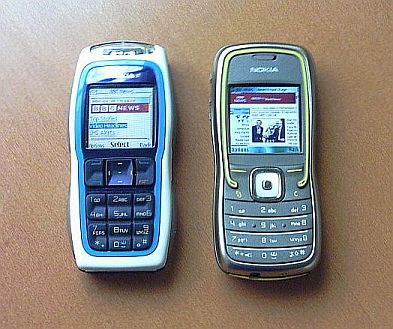
What's this? Surely it can't be a smartphone, it's too small and light!
But the Nokia 5500 is a smartphone, although you wouldn't know it from the marketing which makes out that it's just a normal cameraphone with a tough casing. There's the telltale S60 squiggly menu key though, so what should someone make of this gadget?
Well, the truth is that it's a smartphone which has had various features added and altered to make it an exercise phone, and it seems to work. The S60 side is pretty much what you get on other current S60 3rd Edition models, so this review will concentrate on what the 5500 adds, and takes away, to make it a durable out-of-doors device.
The basics first though: the 5500 is a tri-band GSM Symbian S60 3rd Edition smartphone with EDGE, Bluetooth, infrared, pop-port, 8 megabytes of internal memory, a microSD memory card slot (which officially can take up to 1 gigabyte cards, but I've had reports of people using 2 gigabyte cards as well) and a 64 megabyte microSD card containing extra applications and licensed music tracks. The phone includes a 2 megapixel camera, an FM radio, a pedometer (step counter) and an LED torch. For those who want a more detailed point-by-point technical rundown on the 5500, you can find it on Nokia's official 5500 page, and you might also want to also take a look at Rafe's excellent hands-on preview of the 5500 prototype from May of this year.
According to Nokia the 5500 is "designed to withstand knocks, dust and water splashes". I didn't test these claims personally, but a Russian website called mforum.ru put the 5500 through its paces in some rather extreme situations, and it seemed pretty much indestructible. You can find out more about their tests by clicking here.
(Incidentally, if you've already have a 5500, make sure you insert the free microSD card and let it automatically install all the software on the phone as there's some very handy things on there including several features discussed in this review.)
What's It Like?
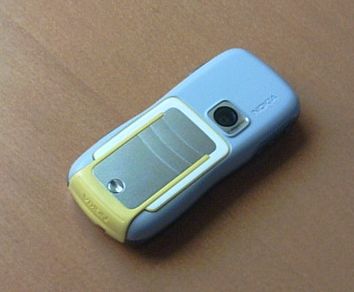 The 5500 is available in grey/black or grey/yellow, and there's a third colour scheme, copper/orange, on the way.
The 5500 is available in grey/black or grey/yellow, and there's a third colour scheme, copper/orange, on the way.
The phone is fairly similar in size to ordinary non-smart monoblock/candybar phones, and comes encased in stainless steel, plastic and rubber. It feels very solid indeed, and as I found out, this is a phone designed to not just take knocks but actually be controlled by them (more on that later in the article). The steel and rubber battery cover is tightly sealed and requires a coin in order to turn the lock open. The SIM card and microSD card are both kept underneath the battery for extra protection, so obviously there's no hotswapping possible. There are no gaps at all in the main casing, the buttons including the keypad are all under rubber surfaces, and there's a rubber flap that covers the pop-port and charging jack.
The keypad buttons were surprisingly nice to use, they press easily and produce a satisfying click, despite being totally covered by rubber. For those who were worried about the narrower bottom keypad row, it works ok, I had no problems. The small buttons at the top had me worried when I saw a photo of the 5500, but in real life they also work fine as they're at different levels on the surface so your thumb can distinguish them easily. The direction pad is smooth and easy to use, and it changes colour to let you know what mode the phone is in. The pen (edit) key has been moved to the right side of the phone, so you can hold it down with one hand while typing a message with the other. There's an infrared port next to the pen key, and a mode key above it which switches between the standby screen, the music player and the pedometer fitness application (each mode also makes the direction pad glow a different colour: white, yellow or red). The mode button uses task switching so you can press it to start the music player and then press it again to access the pedometer, changing modes doesn't kill the previous application. On the left side of the phone there's a pair of volume control buttons and a Push-To-Talk button.
It's also worth mentioning that the 5500 comes supplied with a hands-free pop-port headphone adaptor which contains a microphone, call answer button, volume control, standard headphone jack (standard headphones also included), controls for the music player and radio, and a Push-To-Talk button.
Following in the footsteps of new PCs that expect you to burn your own Windows CDs, there's no PC Suite CD with the 5500, because you're expected to download the latest version from Nokia's web site (and to be fair, Nokia's software updates do seem to come more often now than in the past).
Using the phone as a phone feels good, it's small enough to slip into any compartment in a bag or jacket and it feels a lot less nerdy-looking in public than something like an E61. The sound quality on calls is good, and the battery life is decent for a smartphone, there are about two or three days of use (including phone, texts, exercise app, email and radio) between charges. Thanks to using S60 3rd Edition the speed of the menus and applications are good, close to the speed of a normal phone, and greatly improved from the slow days of S60 1st edition phones. The 5500 also has Push-To-Talk capability, with a dedicated button on the phone itself and a button on the
hands-free adaptor.
Let's Get Physical!
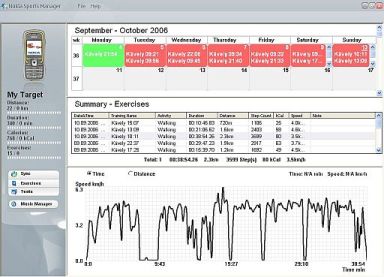 By far the most interesting and important exercise feature on the 5500 is the pedometer or step counter, which uses a 3D sensor to track the distance you've run, walked, rowed or cycled, and it can also be used on a step machine (there are separate settings for all five of these exercise types). As far as I'm aware, this is the first and so far only phone to include a built-in pedometer. It's not quite as precise as an expensive high quality separate pedometer, for example it doesn't ask the user to measure their average step size, but crucially it is consistent, it registered more or less the same distance when I took the same route (I didn't try it with cycling, rowing or a step machine though). It's this consistency that makes it a useful fitness tool because you can use it to track and gradually build up your level of exercise over time so you can get fitter, which is exactly how pedometers are meant to be used.
By far the most interesting and important exercise feature on the 5500 is the pedometer or step counter, which uses a 3D sensor to track the distance you've run, walked, rowed or cycled, and it can also be used on a step machine (there are separate settings for all five of these exercise types). As far as I'm aware, this is the first and so far only phone to include a built-in pedometer. It's not quite as precise as an expensive high quality separate pedometer, for example it doesn't ask the user to measure their average step size, but crucially it is consistent, it registered more or less the same distance when I took the same route (I didn't try it with cycling, rowing or a step machine though). It's this consistency that makes it a useful fitness tool because you can use it to track and gradually build up your level of exercise over time so you can get fitter, which is exactly how pedometers are meant to be used.
To measure your current fitness you can also use the 5500 to help perform the Cooper test (for running and walking) and an exercise bike test, although you'll need access to a stretch of ground of a known length for the Cooper test, and obviously an exercise bike for the bike test. You can set goals which you wish to achieve in several categories (distance, calories, time, number of exercises) along with the time period in which you must achieve them, and you can also switch on an optional voice commentary to tell you how you're doing at regular intervals during the exercise so you don't have to keep checking the display.
There's a diary mode which lets you look back on how much exercise you've done in the past month, and the 5500 is also compatible with the Nokia Sports Manager application for Windows. The application lets you store the diary data from the pedometer on your PC, and view detailed graphs of your speed over distance or time during any particular exercise session you've ever done. Nokia Sports Manager can be downloaded for free from Nokia's web site.
Included in the box is a special clip-on holder which lets you attach the phone to your clothes in order to give extra-accurate measurement using the pedometer, although I found simply keeping the phone in my
pocket was usually accurate enough.
Other Features
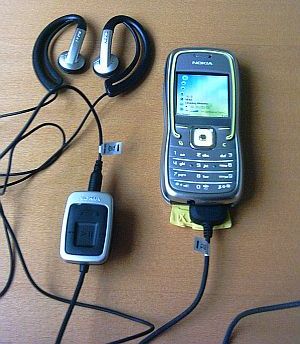 The 5500's built-in music player (compatible with MP3, AAC, AAC+, eAAC+, WMA and AMP) is the same application found on other S60 3rd Edition phones and can be controlled with the keypad, but thanks to the pedometer sensor it can also be controlled by just tapping the phone twice on its sides to skip forward or back, and on the front to pause or play. Just to emphasise that last point, you don't actually push any buttons, you just tap the relevant part of the casing. It seemed to work fairly reliably, although it took a lot of getting used to and there's a couple of seconds delay while the phone works out that you've tapped it. As a third option you can also use the included handsfree headphone adaptor which has FF, RW and Pause buttons on it, and works with standard walkman headphones. The built-in FM radio can also change stations using all three methods, and has visual radio compatibility too.
The 5500's built-in music player (compatible with MP3, AAC, AAC+, eAAC+, WMA and AMP) is the same application found on other S60 3rd Edition phones and can be controlled with the keypad, but thanks to the pedometer sensor it can also be controlled by just tapping the phone twice on its sides to skip forward or back, and on the front to pause or play. Just to emphasise that last point, you don't actually push any buttons, you just tap the relevant part of the casing. It seemed to work fairly reliably, although it took a lot of getting used to and there's a couple of seconds delay while the phone works out that you've tapped it. As a third option you can also use the included handsfree headphone adaptor which has FF, RW and Pause buttons on it, and works with standard walkman headphones. The built-in FM radio can also change stations using all three methods, and has visual radio compatibility too.
There are about a dozen exercise-themed licenced music tracks on the included microSD card to be used while training, or you can of course download and listen to your own tracks from your PC using the PC Suite's Music Manager software or Windows Media Player integration. The included free microSD card is 64 megabytes, but you can buy your own microSD cards with up to 2 gigabytes in capacity. The sound quality of the music player and radio is good, and Nokia is apparently going to launch a "music edition" 5500 package later this year which includes a copper coloured phone and a high capacity microSD, but is otherwise identical to the standard sports package. The external speaker sound quality is also good but in mono as there's just one external speaker.
If you get a message while running and don't want to stop, you can make the phone read out loud any new text messages by tapping it twice. There's a variety of language and voice packs for the speech function both built-in and available to download from Nokia's web site (although curiously there's no Finnish language pack yet), and judging by the names included with the packs it seems they want to turn speech packs into another way of customising your phone, like wallpapers or ringtones. Perhaps we'll see celebrity speech packs appearing one day?
The pedometer has one final trick up its sleeve, it can sense the orientation of the phone when you're standing still, and this function is exploited by the built-in Groove Labyrinth game. It's a sort of real world update of Marble Madness, where you have to tilt the phone itself to steer a ball through a maze while collecting bonuses within a time limit. The game is simple but fun and innovative. Conventional non-tilting games on the phone include the brilliant N-Gage game Snakes, and the frighteningly ubiquitous Sudoku.
The 5500 has a 2 megapixel camera which, like most cameraphones, is at its best in daylight and very brightly lit rooms, but goes grainy when used indoors at night. This can be helped to some extent by using the night mode option, although it's still not as sharp as in daylight. Videos (at a much lower 176x144 resolution) with sound can also be captured using the camera. Pictures and videos can be sent as multimedia messages, transferred over Bluetooth and infrared, sent to your computer through the PC Suite application, or attached to emails. There's no bundled photo editing software, but of course you can edit the pictures on your PC.
Here are some unaltered photos taken with the 5500's camera, the first two in daylight and the third one inside a well-lit room: Example One , Example Two , Example Three
Screen Test
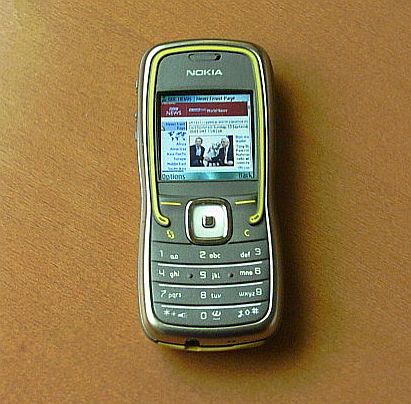 The screen is possibly the most controversial feature of the 5500 for those wanting a pure smartphone as it's physically much smaller than other S60 screens. A large screen would be more vulnerable to damage and the designers of an exercise phone clearly don't want it to feel fragile in any way, so this may be a good tradeoff if you intend to use the 5500 for its stated purpose as a rugged outdoors phone. The screen is a technical improvement on previous generation S60s (208 by 208 pixels, 262 thousand colours) but the physical size is smaller, it measures about 3cm by 3cm, and the size of the text in some applications may be too small for some people's eyesight. The fitness app uses very large font sizes so it works fine with no problems, and writing a text message produces no problems either, but things like viewing web sites on the smallest font setting may be tricky for those who have trouble reading ingredients lists on chocolate bars. You can install S60 3rd Edition apps on the 5500, but as they're usually designed with a larger physical screen in mind, they can be tricky to read too. The standby screen is also a bit crowded if you have a music track running and calendar appointments and to-do notes visible.
The screen is possibly the most controversial feature of the 5500 for those wanting a pure smartphone as it's physically much smaller than other S60 screens. A large screen would be more vulnerable to damage and the designers of an exercise phone clearly don't want it to feel fragile in any way, so this may be a good tradeoff if you intend to use the 5500 for its stated purpose as a rugged outdoors phone. The screen is a technical improvement on previous generation S60s (208 by 208 pixels, 262 thousand colours) but the physical size is smaller, it measures about 3cm by 3cm, and the size of the text in some applications may be too small for some people's eyesight. The fitness app uses very large font sizes so it works fine with no problems, and writing a text message produces no problems either, but things like viewing web sites on the smallest font setting may be tricky for those who have trouble reading ingredients lists on chocolate bars. You can install S60 3rd Edition apps on the 5500, but as they're usually designed with a larger physical screen in mind, they can be tricky to read too. The standby screen is also a bit crowded if you have a music track running and calendar appointments and to-do notes visible.
The excellent new S60 HTML browser included with the phone loads most pages quickly and accurately, usually pretty much as they would appear on a PC browser, as the S60 browser is compatible with things like javascript and frames. If your eyes can cope with the smallest font size on the 5500's screen, the browser can fit about 50% of a page's width on-screen, so you don't have to scroll too much. Unfortunately in a moment of madness someone at Nokia decided that the default browser on the 5500 wouldn't be S60, but the awful outdated Services browser instead, and a link to Services appears on the main menu screen and the standby screen's row of icons. It's likely that most people will never even find the S60 browser as it requires an installation from the included microSD card and even then is buried in the "My Own" folder. To add to the confusion, the icon for Services is almost identical to the S60 Browser icon. It's a mystery why Nokia persists in including the hopeless Services browser when a much better replacement is also included.
Symbian In The Closet
This leads to the most intriguing mystery about the 5500: why is Nokia keeping its smartphone status a secret? Nowhere on the official 5500 tech spec page does it mention "Series 60" or "smartphone", yet the 5500 is technically speaking just as much an S60 smartphone as an N93 or an E61, you can even install S60 3rd edition programs on it. Does this phone represent some experiment to do with using Symbian across Nokia's entire phone range? It can't happen quite yet, the battery life needs to be extended and the S60 user interface needs to be made more intuitive, but that's relatively fixable in future models (and the 5500's colour-coded mode button seems to be a first step). What's remarkable about the 5500 is that it has shown that you can cram so much into such a small, light and durable package: a smartphone almost as fast to use as a normal phone, a thick steel-rubber-plastic casing, a pedometer, a 2 megapixel camera, a memory card slot and an FM radio. It proves that smartphones no longer need to be bulky, and given this achievement it wouldn't be at all surprising if we saw a RAZR-style S60 appear in the near future, especially as Nokia has recently announced that its priority now is to make thinner phones.
At The End Of The Day...
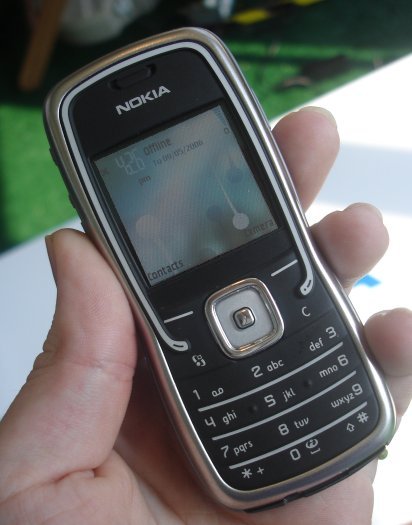 So, should you get a 5500? It depends on what you want. For some people it will be absolutely perfect, while for others the features won't match their needs.
So, should you get a 5500? It depends on what you want. For some people it will be absolutely perfect, while for others the features won't match their needs.
If you primarily need an exercise tool or a durable companion on the road, this is the bee's knees. It's clearly been designed to be a jogger's friend, it has a music player and radio to keep you company, it's the most well-protected and durable smartphone on the market, and it's also (as far as I know) the only phone with a pedometer in it. You don't even need to look at it to change tracks, alter stations, take calls or hear texts, so it's good for keeping in your pocket or clipping to your clothes while you concentrate on collecting kilometres.
If you primarily need a pure smartphone, with mainly visual or high bandwidth uses, and want to browse lots of web sites, watch lots of videos or run lots of third party S60 apps, this probably isn't the phone for you as the screen is physically so small and there's no Wi-Fi or 3G compatibility.
If you need a mixture of these two extremes, then it's up to you to weigh up what features are most important to you. Don't get me wrong, this is a decent smartphone in its own right and it's better than anything from previous smartphone generations, but obviously it has to be compared to other brand new models as well. The 5500 has been largely designed to work around you, rather than begging for your direct attention, and in this field it's absolutely great.
In short, the Nokia 5500 is the first truly durable and portable smartphone, but that durability inevitably brings certain restrictions with it. If the E61 is a Limousine and the N93 is a Ferrari, the 5500 is a Range Rover.
PS: You can watch a video of the 5500's main features in action, and see some high resolution photos, over at the Nokia 5500 page on the Nokia Duck blog.
Reviewed by krisse at
